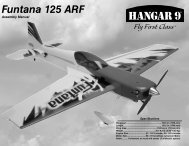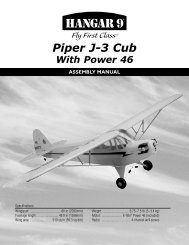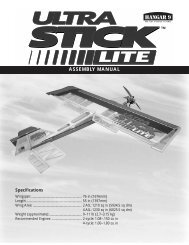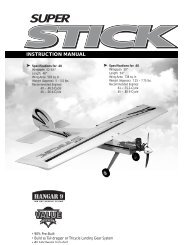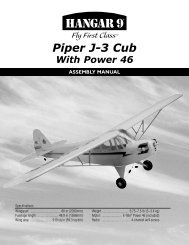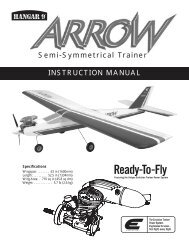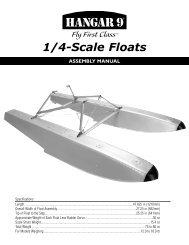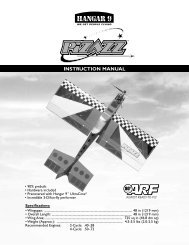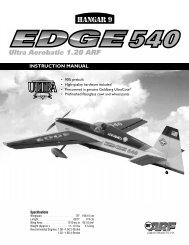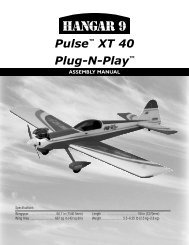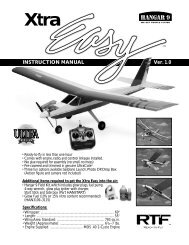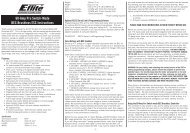ASSEMBLY MANUAL B-25 Mitchell ARF - RC DEPOT
ASSEMBLY MANUAL B-25 Mitchell ARF - RC DEPOT
ASSEMBLY MANUAL B-25 Mitchell ARF - RC DEPOT
You also want an ePaper? Increase the reach of your titles
YUMPU automatically turns print PDFs into web optimized ePapers that Google loves.
TakeoffPrior to your first flight we recommend that you dosome low speed taxi tests. Use these tests to centerthe nose wheel steering to allow for a takeoff straightdown the runway. Once you have finished this be sureand take a minute to refuel the tanks and take one lastlook at the airframe to be sure all screws and controllinkages are secure.The flaps are not needed if you are taking off from a hardpacked runaway such as asphalt and even fields withshort grass do not require the use of flaps. If you aretaking off from a grass field that is rough or has not beenmowed recently, then we recommend that you use thehalf flap position and allow a little extra takeoff roll beforegradually feeding in up elevator. Once you have the B-<strong>25</strong>airborne maintain a shallow rate of climb and allow themodel to gain speed prior to making the first turn. Theflaps should be retracted at this point and you should beentering into the normal traffic pattern. If you are usingretracts then we suggest that you retract the landing gearprior to retracting the flaps.Familiarize yourself with the flight characteristics of theB-<strong>25</strong> and practice flying the model at a safe height usingboth the mid and full flap positions. Be sure and reducethe throttles and allow the B-<strong>25</strong> to slow a bit prior tolowering the flaps to the first or mid position. Then lowerthe flaps to the full position and adjust power to maintainstraight and level flight. You will find that the B-<strong>25</strong> doesnot balloon or pitch up if you allow the model to slowprior to dropping the flaps. We have found that if youfollow this procedure, then you will not need to mix in anydown elevator compensation.LandingTo begin the landing approach you will need to first lowerthe throttles and reduce your flight speed. We recommendthis take place on the downwind leg and that you have theflaps in the full down position prior to beginning your turnto the base leg. Allow the B-<strong>25</strong> to begin a slow downwarddecent and gradually allow the airspeed to bleed off. Theidea is to loose altitude and maintain airspeed by keepingthe nose down in the turn. As you begin your upwindapproach use the throttles to maintain your sink rateand as you pass over the end of the runway reduce thethrottles to idle and begin to add up elevator and beginyour flare to landing. Should you overshoot the landingthe gradually add power and use the rudders to keep theB-<strong>25</strong> on track. Keep the flaps in the full down position andbegin to set up for a second attempt.76



